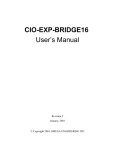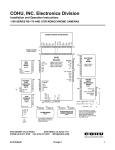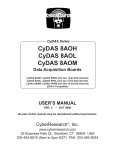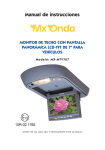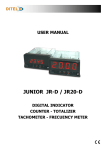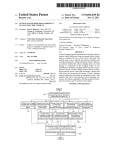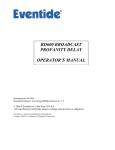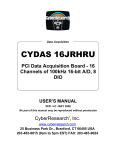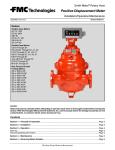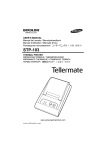Download - CyberResearch
Transcript
CyDAS CyEXP RTD 16-Channel Expansion Multiplexing Panel (RTD Signal Conditioning) USER’S MANUAL VER. 2 • NOV 2000 & No part of this manual may be reproduced without permission. CyberResearch, Inc. www.cyberresearch.com 25 Business Park Dr., Branford, CT 06405 USA 203-483-8815 (9am to 5pm EST) FAX: 203-483-9024 ©Copyright 2000 All Rights Reserved. November 2000 The information in this document is subject to change without prior notice in order to improve reliability, design, and function and does not represent a commitment on the part of CyberResearch, Inc. In no event will CyberResearch, Inc. be liable for direct, indirect, special, incidental, or consequential damages arising out of the use of or inability to use the product or documentation, even if advised of the possibility of such damages. This document contains proprietary information protected by copyright. All rights are reserved. No part of this manual may be reproduced by any mechanical, electronic, or other means in any form without prior written permission of CyberResearch, Inc. TRADEMARKS “CyberResearch,” “CyEXP RTD,” “CyDAS 8,” and “CyDAS 16” are trademarks of CyberResearch, Inc. Other product names mentioned herein are used for identification purposes only and may be trademarks and/or registered trademarks of their respective companies. • NOTICE • CyberResearch, Inc. does not authorize any CyberResearch product for use in life support systems, medical equipment, and/or medical devices without the written approval of the President of CyberResearch, Inc. Life support devices and systems are devices or systems which are intended for surgical implantation into the body, or to support or sustain life and whose failure to perform can be reasonably expected to result in injury. Other medical equipment includes devices used for monitoring, data acquisition, modification, or notification purposes in relation to life support, life sustaining, or vital statistic recording. CyberResearch products are not designed with the components required, are not subject to the testing required, and are not submitted to the certification required to ensure a level of reliability appropriate for the treatment and diagnosis of humans. i ii Table of Contents 1 INTRODUCTION . . . . . . . . . . . . . . . . . . . . . . . . . . . . . . . . . . . . . . . . . . . . . . . . . . . . . . . . . . . . . . 1 2 SOFTWARE INSTALLATION . . . . . . . . . . . . . . . . . . . . . . . . . . . . . . . . . . . . . . . . . . . . . . . . . . 1 3 GENERAL CONFIGURATION . . . . . . . . . . . . . . . . . . . . . . . . . . . . . . . . . . . . . . . . . . . . . . . . . . 2 3.1 A/D BOARD-TYPE SELECT JUMPER . . . . . . . . . . . . . . . . . . . . . . . . . . . . . . . . . . . . . . . . . 2 3.2 SETTING THE OUTPUT CHANNEL . . . . . . . . . . . . . . . . . . . . . . . . . . . . . . . . . . . . . . . . . . . 2 3.3 CONFIGURING THE A/D BOARD . . . . . . . . . . . . . . . . . . . . . . . . . . . . . . . . . . . . . . . . . . . . 3 3.3.1 CyDAS 8 Family Setup . . . . . . . . . . . . . . . . . . . . . . . . . . . . . . . . . . . . . . . . . . . . . . . . . . . . 3 3.3.2 CyDAS 16 Family Setup . . . . . . . . . . . . . . . . . . . . . . . . . . . . . . . . . . . . . . . . . . . . . . . . . . . 3. 3.3.3 All A/D Boards . . . . . . . . . . . . . . . . . . . . . . . . . . . . . . . . . . . . . . . . . . . . . . . . . . . . . . . . . . 3 3.4 CONNECTING THE CYEXP RTD TO THE A/D BOARD . . . . . . . . . . . . . . . . . . . . . . . . . 4 3.4.1 Connecting to a CyDAS 8 Series A/D Board . . . . . . . . . . . . . . . . . . . . . . . . . . . . . . . . . . 4 3.4.2 Connecting to a CyDAS 16 Series A/D Board . . . . . . . . . . . . . . . . . . . . . . . . . . . . . . . . . 4 3.4.3 Other A/D Boards . . . . . . . . . . . . . . . . . . . . . . . . . . . . . . . . . . . . . . . . . . . . . . . . . . . . . . . . 4 3.5 POWERING THE CYEXP RTD. . . . . . . . . . . . . . . . . . . . . . . . . . . . . . . . . . . . . . . . . . . . . . . . . 5 3.5.1 Power Source Switch . . . . . . . . . . . . . . . . . . . . . . . . . . . . . . . . . . . . . . . . . . . . . . . . . . . . . 5 3.5.2 Powering with the 37-Pin Connector: . . . . . . . . . . . . . . . . . . . . . . . . . . . . . . . . . . . . . . . . 5 3.5.3 Powering with the CBL MOL10 cable: . . . . . . . . . . . . . . . . . . . . . . . . . . . . . . . . . . . . . . 5 3.6 DAISY-CHAINING CYEXP RTD BOARD. . . . . . . . . . . . . . . . . . . . . . . . . . . . . . . . . . . . . . . 6 3.7 CONNECTING A VOLTAGE SIGNAL . . . . . . . . . . . . . . . . . . . . . . . . . . . . . . . . . . . . . . . . . 6 3.8 VERIFYING THE INSTALLATION . . . . . . . . . . . . . . . . . . . . . . . . . . . . . . . . . . . . . . . . . . . . 6 4 VOLTAGE MEASUREMENT CONFIGURATION . . . . . . . . . . . . . . . . . . . . . . . . . . . . . . . . 7 4.1 CHANNEL SELECTION . . . . . . . . . . . . . . . . . . . . . . . . . . . . . . . . . . . . . . . . . . . . . . . . . . . . . . 7 4.2 POWER SOURCE SWITCH . . . . . . . . . . . . . . . . . . . . . . . . . . . . . . . . . . . . . . . . . . . . . . . . . . . 7 4.3 DETERMINING THE APPROPRIATE GAIN . . . . . . . . . . . . . . . . . . . . . . . . . . . . . . . . . . . . 7 4.4 SETTING THE GAIN . . . . . . . . . . . . . . . . . . . . . . . . . . . . . . . . . . . . . . . . . . . . . . . . . . . . . . . . . 8 4.4.1 First Stage Gain Switch . . . . . . . . . . . . . . . . . . . . . . . . . . . . . . . . . . . . . . . . . . . . . . . . . . . 8 4.4.2 Second Stage Gain Switch . . . . . . . . . . . . . . . . . . . . . . . . . . . . . . . . . . . . . . . . . . . . . . . . 8 4.5 ATTENUATION . . . . . . . . . . . . . . . . . . . . . . . . . . . . . . . . . . . . . . . . . . . . . . . . . . . . . . . . . . . . . 9 4.6 CHANNEL CONFIGURATION SWITCH . . . . . . . . . . . . . . . . . . . . . . . . . . . . . . . . . . . . . . . 9 4.7 CONNECTING VOLTAGE SIGNALS . . . . . . . . . . . . . . . . . . . . . . . . . . . . . . . . . . . . . . . . . . 9 4.7.1 Single Ended . . . . . . . . . . . . . . . . . . . . . . . . . . . . . . . . . . . . . . . . . . . . . . . . . . . . . . . . . . . . 9 4.7.2 Floating Differential . . . . . . . . . . . . . . . . . . . . . . . . . . . . . . . . . . . . . . . . . . . . . . . . . . . . . 10 4.7.3 Fully Differential . . . . . . . . . . . . . . . . . . . . . . . . . . . . . . . . . . . . . . . . . . . . . . . . . . . . . . . 11 5 RTD MEASUREMENT CONFIGURATION . . . . . . . . . . . . . . . . . . . . . . . . . . . . . . . . . . . . . 12 5.1 CHANNEL SELECTION . . . . . . . . . . . . . . . . . . . . . . . . . . . . . . . . . . . . . . . . . . . . . . . . . . . . . 12 5.2 POWER SOURCE SWITCH . . . . . . . . . . . . . . . . . . . . . . . . . . . . . . . . . . . . . . . . . . . . . . . . . . 12 5.3 DETERMINING THE APPROPRIATE GAIN . . . . . . . . . . . . . . . . . . . . . . . . . . . . . . . . . . . 12 5.4 SETTING THE GAIN . . . . . . . . . . . . . . . . . . . . . . . . . . . . . . . . . . . . . . . . . . . . . . . . . . . . . . . . 13 5.4.1 First Stage Gain . . . . . . . . . . . . . . . . . . . . . . . . . . . . . . . . . . . . . . . . . . . . . . . . . . . . . . . . 14 5.4.2 Second Stage Gain . . . . . . . . . . . . . . . . . . . . . . . . . . . . . . . . . . . . . . . . . . . . . . . . . . . . . . 14 5.5 CHANNEL CONFIGURATION SWITCH . . . . . . . . . . . . . . . . . . . . . . . . . . . . . . . . . . . . . . 15 5.6 CONNECTING THE RTD TO THE SCREW TERMINALS . . . . . . . . . . . . . . . . . . . . . . 15 iii 5.6.1 Two-wire RTD Hookup . . . . . . . . . . . . . . . . . . . . . . . . . . . . . . . . . . . . . . . . . . . . . . . . . . 5.6.2 Three-Wire RTD Hookup . . . . . . . . . . . . . . . . . . . . . . . . . . . . . . . . . . . . . . . . . . . . . . . . 5.6.3 Four-Wire RTD Hookup . . . . . . . . . . . . . . . . . . . . . . . . . . . . . . . . . . . . . . . . . . . . . . . . . 5.7 CALIBRATION AND TEST . . . . . . . . . . . . . . . . . . . . . . . . . . . . . . . . . . . . . . . . . . . . . . . . . . 6 CUSTOM GAIN AND EXCITATION CALCULATIONS . . . . . . . . . . . . . . . . . . . . . . . . . 6.1 CUSTOM EXCITATION CURRENT - R89 . . . . . . . . . . . . . . . . . . . . . . . . . . . . . . . . . . . . . 6.2 CUSTOM SECOND STAGE GAIN RESISTOR - RX100 . . . . . . . . . . . . . . . . . . . . . . . . . 7 SPECIFICATIONS . . . . . . . . . . . . . . . . . . . . . . . . . . . . . . . . . . . . . . . . . . . . . . . . . . . . . . . . . . . . iv 16 16 17 17 17 17 18 19 1 INTRODUCTION The CyEXP RTD is a signal conditioning accessory designed for use with the CyDAS 8 and CyDAS 16 family of data acquisition boards. Circuitry to excite selected RTDs on a per channel basis converts the RTD's output current to a voltage suitable for conversion by a CyDAS 8 or other analog-to-digital conversion board. This manual is loosely organized into sections that explain the CyEXP RTD: Installation: Installation and initial setup. Voltage Reading: Explains how to set up for and make voltage only readings. RTD: Describes how two, three, and four-wire type RTDs are connected. Please carefully read the Installation section and follow the initial installation and test steps. Verify the installation with a voltage measurement prior to connecting RTDs and attempting to measure temperature. 2 SOFTWARE INSTALLATION There is no software shipped with the CyEXP RTD. The CyEXP RTD is an accessory board intended to be used with an A/D board such as a CyDAS 8 or CyDAS 16. A program called InstaCal is shipped with every DAS board. InstaCal has installation information in it about the CyEXP RTD. Refer to the Software Installation Manual for complete information. To update the InstaCal configuration file to include CyEXP RTD information, start InstaCal, select the board number of the DAS board that has the CyEXP RTD connected to it, and select the channel number the CYEXP RTD is connected to. The options for the CYEXP RTD will be available to set and change. After this is done, you can use the InstaCal calibrate and test options. You must use InstaCal to update and configure the configuration file CB.CFG to include the CyEXP RTD settings before you can use the CyEXP RTD with InstaCal, Universal Library and some applications packages. Initially, accept the default settings so that you can verify the installation. You may have to go back and make changes with InstaCal once you have selected a sensor and read the section on installing that sensor. 1 3 GENERAL CONFIGURATION 3.1 A/D BOARD-TYPE SELECT JUMPER The CyEXP RTD may be used with either CyDAS 8 or CyDAS 16 family boards because the signal assignments of the 37 pin connector match those of the CyDAS 8, and may be adapted to those of the CyDAS 16 with a CyEXP DAS16-10 cable. Jumper JB10 on the CyEXP RTD board located near the 37-pin connectors is used to select the either the CyDAS 8 or CyDAS 16 A/D board family. Select the A/D board type ( CyDAS 8 or CyDAS 16) using the JB 10 jumper (Figure 3-1). DAS08 DAS16 The jumper is shown here with the CyEXP RTD configured for use with a CyDAS 8 family board. Figure 3-1. DAS08/16 Select Jumper 3.2 SETTING THE OUTPUT CHANNEL Jumper positions labeled “CH SEL” located near the 37-pin connectors are used to select one CyEXP RTD output channel to which the output from the addressed RTD will be connected. This setting determines which A/D channel is used to acquire data from the CyEXP RTD when it is connected to an A/D board. 37 D CONNECTOR OUTPUT CHANNEL SELECT 37 0 36 1 35 2 When the CyEXP RTD is connected to a CyDAS 8 series board, any one of the first 8 channels (labeled 0-7) may be used. 34 3 33 4 32 5 31 6 30 7 18 8 17 9 When the CyEXP RTD is connected to a CyDAS 16 series board, any one of 16 jumper positions may be used. 16 10 15 11 In each case, the jumper corresponds to an input channel number on the A/D board. See Figure 3-2 and 3-3. 14 12 13 13 12 14 11 15 INPUT 0 INPUT 1 AM P G A IN 1 OR 7 AM P G A IN 1 ,2 , 4 , 8 16-CHANNEL 8 CHANNEL MULTIPLEXER MULTIPLEXOR There are 16 jumpers for the output. Each jumper corresponds to one of the 16 output pins on the 37-pin connector. INPUT 2 INPUT N INPUT N + 1 INPUT 13 INPUT 14 MUX CONTROL 7-10 INPUT 15 Figure 3-2. Channel-Selection Block Diagram 2 NOTE: If the jumper setting does not agree with the selection made in InstaCal setup, InstaCal and the Universal Library will not be able to make readings from the CyEXP RTD. One individual channel must be selected for each bank of 16 EXP channels. For example, if you are using several CyEXP RTD boards, the jumper setting for each board must be unique. If you select channel 0 for the first board, do not use this channel for any of the other boards. Figure 3-3 is a diagram of the jumper positions. 0 1 2 3 4 5 6 7 Place the jumper on the pin which corresponds to the A/D board's input channel. 8 9 10 11 12 13 14 15 CH SEL CHANNEL 0 SELECTED FOR BOARD OUTPUT Figure 3-3. Channel Selection Jumper Locations 3.3 CONFIGURING THE A/D BOARD 3.3.1 CyDAS 8 Family Setup The input mode of the A/D board must be single-ended to be compatible with the CyEXP outputs. Some of the boards in the CyDAS 8 series have differential inputs that can be converted to single-ended inputs. See the information shipped with your A/D board for conversion to single-ended inputs. 3.3.2 CyDAS 16 Family Setup The input mode of the A/D board must be single-ended to be compatible with the CyEXP outputs. Most of the CyDAS 16 series is switch selectable for either 8 differential or 16 single-ended inputs. When used with the CyEXP, set the switch to 16-channel, single-ended mode. 3.3.3 All A/D Boards If the range of your A/D board is switch selectable and you are using RTDs, set the range of the A/D board to 5V Unipolar, if available, or 10V Unipolar if not. Some software packages base the calculation of temperature on these ranges only. (The optional Universal Library does allow other ranges, but 5V Unipolar is preferred.) If your A/D board has a UNI / BIP switch (for setting the range to either unipolar or bipolar), the preferred setting is UNI (unipolar). If the range on your A/D board is fully programmable, the software you use for temperature measurement will determine the correct range to use If you are not using RTDs, set the range of the A/D board to accommodate the maximum output expected from the CyEXP RTD board. 3 3.4 CONNECTING THE CYEXP RTD TO THE A/D BOARD 3.4.1 Connecting to a CyDAS 8 Series A/D Board A CyDAS 8 series board may be connected directly through a C37FF series cable from the P1 connector on the CyEXP RTD to the A/D analog connector. The JB10 jumper should be left in the CyDAS 8 position as set at the factory. 3.4.2 Connecting to a CyDAS 16 Series A/D Board The CyEXP can be used with CyDAS 16 series boards, expanding the CyDAS 16's 16 inputs to 256 inputs. The connection requires a special 37-conductor cable (CBL MX10) since pin relationship of CyEXP and DAS16 signals is not 1:1. Install the CBL MX10 cable connector labeled “MUX” into the P1 connector of the CyEXP RTD board and the other end into the CyDAS 16 series board’s analog connector. 3.4.3 Other A/D Boards If you need to connect to a board other than those described above, call technical support. We may have the cable you need. Alternatively, you could use this connector diagram to construct a cable. NC / LLGND 19 LLGND / OUTPUT 8 18 OUTPUT 9 The signal from the CyEXP RTD is a multiplexed voltage from each RTD input to a single jumper-selected channel and an analog ground (LLGND). There should be no voltage between analog ground and power ground. OUTPUT 10 OUTPUT 11 OUTPUT 12 OUTPUT 13 OUTPUT 14 The MUX address lines control the setting of the channel multiplexer. When all are low, the mux is set to channel 0. The lines are binary coded with MUXADDR1 being the LSB and MUXADDR4 being the MSB. 16 15 14 13 12 OUTPUT 15 11 MUX ADDR 4 10 MUX ADDR 3 MUX ADDR 2 MUX ADDR 1 NC NC The output digital address lines from an A/D card are typically named Dig. Out 0 to Dig. Out 3 respectively. 17 NC NC 9 8 7 6 5 4 3 NC 2 NC 1 37 OUTPUT 0 36 OUTPUT 1 35 OUTPUT 2 34 OUTPUT 3 33 OUTPUT 4 32 OUTPUT 5 31 OUTPUT 6 30 OUTPUT 7 29 +5 VOLTS FROM PC 28 POWER GROUND 27 NC 26 NC 25 NC 24 NC 23 NC 22 NC 21 NC 20 NC Figure 3-4. 37-Pin Connector Pin-Out 4 3.5 POWERING THE CYEXP RTD The CyEXP RTD can be powered through the 37-pin cable or the Molex connector. The power that can be carried through the 37-pin connector is limited so we recommend this only when a single CyEXP RTD is used. The power required to run a CyEXP RTD channel is dependent on the sensor connected to it. Voltage measurements do not draw additional power from the CyEXP RTD, but RTDs do for the excitation current. 3.5.1 Power Source Switch CUSTOM IEXC X1 When positioned down, (+5 COMP), the +5V power is drawn from the personal computer through the signal cable. In the +5REM position (up) power is drawn through the MOLEX connector. +5 REM One of the switches on the four-position DIP switch labeled “2” controls the source of the +5V power to the CyEXP RTD. N O 4 3 2 1 IEXC=1MA +5 COMP GND X7 The right-hand switch selects the source of the excitation current. The choices are 1 mA source or a custom current selected by installing a resistor at R89. Figure 3-5. Power Source Switch 3.5.2 Powering with the 37-Pin Connector: You may power the CyEXP RTD via the 37-pin cable. Only one CyEXP RTD can be powered via the 37-pin cable. If you are powering multiple boards, use the CBL MOL10 cable. 3.5.3 Powering with the CBL MOL10 cable: The CyEXP RTD may be powered from the PC's power supply by connecting it to that power supply through a CBL MOL10 cable. This cable has the same Molex connector that is used inside the PC and so may be connected directly to the PC's power supply through one of the spare connectors. The cable is keyed, so it should not be forced. When inserted properly it will slide easily and snap in place. 5 3.6 DAISY-CHAINING CYEXP RTD BOARDS Connect one CyEXP RTD to another using a CBL 37-# ribbon cable. Connect from P2 on the ‘upstream’ board to P1 on the ‘downstream’ board. Make sure each of the boards in the chain have a unique channel selected (CH SEL jumper is set to a different number on each board). 3.7 CONNECTING A VOLTAGE SIGNAL Make your initial test of the CyEXP RTD with a simple voltage signal of between 0 and 5V. If you have a variable signal source, all the better. Each input circuit has four screw terminals associated with it. These terminals are shown in Figure 3-6 to the right. Add Jumper CH0 -IEXC Signal-Low (Gnd.) Connect the Ground to this +IEXC -SENSE Place a wire between this and -IEXC +SENSE +SENSE Connect the + voltage to this −IEXC −SENSE To connect a voltage signal to the input circuit you need only use three screw terminals, these are: Voltage Source Signal-High Single-Ended Voltage Input Figure 3-6. Connection Terminal Block for Voltage Test (Channel 0 Shown) There is not room on the board for the full name next to each terminal so the eight screw terminals associated with each input circuit are labeled on the CyEXP RTD as follows: +IEXC High side of RTD excitation current +SENSE High side of input signal from voltage or RTD current -IEXC Low side of excitation current or chassis ground for volts -SENSE Low side of input signal from voltage or RTD The use of the terminals is dependent on the type of sensor you have connected to the input circuit, and the nomenclature on the terminals has been chosen to make the most sense for RTD sensors. 3.8 VERIFYING THE INSTALLATION To verify the installation, test or calibrate the CyEXP RTD, use the InstaCal program installed on your computer. This software came with your A/D board if you bought the board from the same manufacturer as the CyEXP RTD. If your A/D board is not from the same manufacturer but is compatible, please call technical support and request a copy of InstaCal. Use InstaCal's TEST option to verify that a signal present at one of the CyEXP RTD's inputs can be read. You will not need to set any jumpers other than those previously mentioned, and should not set any switches or install any passive components until you have verified the installation. 6 4 VOLTAGE MEASUREMENT CONFIGURATION The CyEXP RTD is an amplification, signal conditioning and multiplexing accessory for DAS boards. The inputs are suitable for connecting a voltage to the DAS board so it may be measured. The CyEXP RTD is a “one of sixteen” multiplexer which means that for every channel in your DAS board, you can multiplex sixteen different signals into it. You can expand the number of inputs of your DAS board by sixteen for every CyEXP RTD board, up to the number of inputs on the DAS board. For example, a CyDAS 8 has eight inputs. Eight times sixteen is one hundred and twenty eight. Using CyEXP RTD boards, you can bring 128 inputs into the PC with one CyDAS 8 in one slot. It is unlikely that you purchased a CyEXP RTD to measure voltages. The CyEXP RTD has quite a bit of special circuitry designed for RTD sensors. For only voltage measurements, a CyEXP 16 or CyEXP 32 would be less expensive and do the same job. However, you may have one or two voltages to measure in addition to RTD sensors and would like to connect those signals to the CyEXP RTD. This chapter explains how to make those connections. 4.1 CHANNEL SELECTION The General Configuration section describes the channel selection, setting the jumper and verifying the installation and operation of the CyEXP RTD with your data acquisition board. Configure your boards as described in that section before continuing with this section. 4.2 POWER SOURCE SWITCH The General Configuration section describes the power selection options, setting the power select switch and verifying the installation and operation of the CyEXP RTD with your data acquisition board. Configure your boards as described in that section before continuing with this section. 4.3 DETERMINING THE APPROPRIATE GAIN To accurately measure a voltage, the full scale of the signal should be matched to the full range of the input circuit. Most DAS boards have an input range of ±5V, which is the native range of the analog to digital converter at the heart of the board. Some DAS boards include amplification on the input circuit to allow the signal to be amplified to make better use of the resolution of the A/D. For example, a sine wave which varies between 0 and 1 volt would only be using 1/10th of the ±5V A/D converter's resolution. By switching the input signal of the DAS board to unipolar (no negative voltage) and amplifying the sign wave signal by 5, the entire range of the A/D converter is used and a higher resolution measurement may be made. In order to match your signals with the input range of the A/D board, you should do a similar calculation and set switches on the CyEXP RTD for the correct gain. Gain, or amplification, allows you to boost your signal to take full advantage of the resolution of the A/D converter. While amplifying the signal, any noise is amplified as well. If your signal ranges greater than ±5V, please go to section on attenuation. The first stage has gain options of 1, 2, 4 or 8 and the second stage gain options are 1, 7 or CUSTOM. 7 To choose a switch-selectable amplification, calculate as follows: If your signal is bipolar, divide 10 by the full range of the signal. For example, if your signal ranges between ±1/2 volt, the full range is 1 volt. Divide 10 by 1 for a result of 10. That is the maximum gain you can use. If your signal is unipolar and ranges less than 0 to 5V, divide 5 by the full range of the signal. For example, if the signal ranges from 0 to 1/2 volt, the full range is 1/2 volt. Divide 5 by 0.5 for a result of 10. That is the maximum gain you can use. 4.4 SETTING THE GAIN 4.4.1 First Stage Gain Switch A set of three Gain Select switches on the S1 switch block selects the first stage gain (Figure 4-1). The fourth switch on this block (marked CUSTOM) is used to select a custom second stage gain. GAIN SELECT When all three switches are up, the first stage gain is 1. Moving a switch down selects that gain. The other two switches should be up. (Gains choices for the first stage are NOT additive.) O N X8 X4 X2 CUSTOM Thus, gains of 1, 2, 4 or 8 can be selected by these switches. A gain of X2 is shown in Figure 4-1. Figure 4-1. First Stage Gain Select Switches (S1) 4.4.2 Second Stage Gain Switch CUSTOM IEXC +5 REM X1 Switch #3 on the S2 DIP switch block (Figure 4-2) is labeled X1 and X7. Setting this switch down (ON) will amplify the output of the first stage amplifier by 7. The factory default position (up) has a gain of 1 (unity). When set to X7, the first stage gain is multiplied by 7 yielding overall gains of 7, 14, 28 or 56. N O 4 3 2 1 IEXC=1MA +5 COMP GND X7 A custom second stage gain of greater than 7 and less than 64 may be added by installing a precision resistor at RX100 and setting the switch marked CUSTOM on. Figure 4-2. Second Stage Gain Switch (#3 of S2) 8 When using the custom second stage gain, set the switch marked CUSTOM on the S1 bank to the ON position (down) and set the X7 switch on the S2 bank to the ON position (X7). Install a precision resistor of the appropriate value in the RX100 location. Calculate the value using the formula found in the Custom Gain and Excitation Calculations chapter. 4.5 ATTENUATION RES IN If your signal range is greater than ±5V, you will have to divide it until the result is less than or equal to ±5V for bipolar, or 0-5V for unipolar signals. INPUT Ra A voltage divider is constructed from a pair of precision resistors selected according to the equation: Attenuation = (R1 + R2) / R2 RES IN OUT Volts In Rb RES OUT PC GROUND Volts Divided PC GROUND RES OUT You will need to construct the voltage divider remote from the CyEXP RTD. Figure 4-3. Voltage Divider Schematic 4.6 CHANNEL CONFIGURATION SWITCH O N O N Set for 2 or 4-Wire Connection 3 4 3 4 1 NOTE: When doing voltage measurements, set the switches to the 4-wire position (switches labeled “4” in white on the board in the ON position - switches labeled “3” OFF). INPUT CONFIG 3 4 3 4 A channel configuration switch is associated with each channel. The switch is used to configure the input circuit for 2, 3 or 4-wire hookup to RTDs. 0 Set for 3-Wire Connection Figure 4-4. Channel Configuration Switches 4.7 CONNECTING VOLTAGE SIGNALS Voltage signals may be single ended or differential, and the full scale may have to be matched to the range of the CyEXP RTD and DAS board combination via amplification or division. To connect a voltage and make an accurate measurement, each of these factors must be considered. 4.7.1 Single Ended A single-ended input has two wires; a signal high and a Ground (−IEXC). The Low Level Ground signal must be the same ground the PC is on. Single-ended mode is selected by installing a jumper between the signal input low and ground (−SENSE to −IEXC) (Figure 4-5). 9 Each input circuit has four screw terminals associated with it. These terminals are shown in Figure 4-5 to the right. Add Jumper CH0 +IEXC +SENSE +SENSE Signal high, or CH HI on a DAS board −IEXC −SENSE To connect a voltage signal to the input circuit you only use three screw terminals; these are: Voltage Source Signal-Low (Gnd.) Signal-High -SENSE Signal low, or CH LO on a DAS board Single-Ended Voltage Input -IEXC Low Level Ground (LLGND) Figure 4-5. Single-Ended Voltage Input 4.7.2 Floating Differential Add 10K Resistor A floating differential hookup is handy when the signal source is floating with respect to ground, such as a battery-powered device. The floating differential input will reject up to 10V of EMI energy on the signal wires. Voltage Source +IEXC Signal-Low +SENSE −IEXC −SENSE A floating differential input has two wires from the signal source and a 10K ground reference resistor installed at the CyEXP RTD input. The two signals from the signal source are Signal High and Signal Low. The reference resistor is connected between the CyEXP RTD -SENSE and -IEXC pins (Figure 4-6). Signal-High Floating-Differential Voltage Input Figure 4-6. Floating-Differential Voltage Input CAUTION: Verify that the signal source is really floating. Check it with a voltmeter before risking the CyEXP RTD and PC! 10 4.7.3 Fully Differential +IEXC +SENSE −IEXC −SENSE A differential signal has three wires from the signal source. The signals are Signal High, Signal Low and Signal Ground (-IEXC) (which is LLGND). A differential connection allows you to connect the CyEXP RTD to a signal source with a ground that is different from the PC ground, but less than 10V difference, and still make a true measurement of the signal. Ground cable shield at –IEX terminal only. EXAMPLE: A laboratory instrument with its own wall plug. Signal-Low NOTE: There are sometimes voltage differences in wall GND between outlets. Measure it to verify that it doesn’t exceed 10V. Voltage Source Signal-High Differential Voltage Input Figure 4-7. Differential Voltage Input 11 5 RTD MEASUREMENT CONFIGURATION An RTD is a temperature sensor that consist of a resistive element, usually a length of wire encased in a sheath. Various wire materials are used with platinum being the most common. There are three types of hookups: two-wire, three-wire, and four-wire. 5.1 CHANNEL SELECTION The General Configuration section describes the channel selection, setting the jumper and verifying the installation and operation of the CyEXP RTD with your data acquisition board. Configure your boards as described in that section before continuing with this section. 5.2 POWER SOURCE SWITCH The General Configuration section describes the power selection options, setting the power select switch and verifying the installation and operation of the CyEXP RTD with your data acquisition board. Configure your boards as described in that section before continuing with this section. 5.3 DETERMINING THE APPROPRIATE GAIN To select the best gain for RTD type, base resistance and temperature range, consider that RTD resistance changes with temperature, but the magnitude of the change also changes with temperature. RTD type determines the ‘slope’ of the ohms vs. temperature curve. The most popular type has an ‘alpha’ of .00385, known as the European standard. Its value is .00385 ohms per ohm per °C. The Universal Library and InstaCal support six different RTD types. Please call if you do not see the RTD you are interested in listed here. Material ‘alpha’ Platinum Platinum Platinum Copper Nickel/Iron Nickel/Iron 0.00392 American standard 0.00391 0.00385 European standard (Most popular, OMEGA’s standard also) 0.00427 0.00581 0.00527 To determine which gain to use, you must know the maximum temperature the RTD will be used to measure, and thus the maximum change in resistance that the RTD will undergo. Here is a table for platinum: 12 For 100 ohm RTD, alpha = .00385: Temp (°C) -200 -100 0 100 200 300 400 Resistance (ohms) 18.49 60.25 100.00 138.50 175.84 212.02 247.04 At a temperature of 400°C, the maximum resistance is 247.04 ohms The equation for the voltage out of the CyEXP RTD (the voltage your DAS board will convert into a number) is: VOUT = IEXC * RRTD * GAIN Normally, the CyEXP RTD supplies 1 mA of excitation current. The choices for standard gains are 1, 2, 4, 7, 8, 14, 28, or 56. Thus, if you want to measure temperature in the range of -200 to 400°C with the RTD listed above, the maximum voltage output would be: V = 0.001 * 247.04 = 0.24704 With a gain of 14, the DAS board will read 3.459 volts. If the gain is 28, the output is 6.917 volts. The DAS board would have to be set to the 0 to 10 volt range. If you are limiting your range of interest to -200 to 100°C, a common range, the calculations are: V = 0.001 * 138.50 = 0.1385. Gain of 28 = 3.878V. Gain of 56 = 7.756V. In this case, a gain of 28 and a range of 0 to 5 volts would be best (0.517 to 3.878 volts would be the temperature range − 200 to 100). A 12-bit A/D converter would be using 67% of its range of 4096 counts, or a total of 2752 counts, or divisions of 300°C. The converter would be able to resolve to 0.109°C. That is more than enough converter resolution even though you are not using the full range of the DAS board in this example. If your DAS board has 16 bits of resolution, the DAS board would resolve to 0.006°C. This is far in excess of the accuracy of the RTD. The stages of gain you choose are not only dependent on the RTD you choose, but on the range of temperature you are measuring. Use the equation above to fine tune the CyEXP RTD circuit to your advantage, then be sure to update the InstaCal program so the Universal Library linearization routines will operate properly. 5.4 SETTING THE GAIN Set the first and second stage gains according to the base resistance of the RTD, the RTD type and the temperature range you intend to measure. The base resistance is the resistance of the RTD at zero degrees Centigrade. The following table is a “quick reference” guide of recommended gains. 13 Base Resistance Stage 1 Gain Stage 2 Gain Total Gain 100 Ohms 8 7 56 1000 Ohms 4 7 28 5.4.1 First Stage Gain A set of three Gain Select switches on the S1 switch block selects the first stage gain (Figure 4-4). The fourth switch on this block (marked CUSTOM) is used to select a custom second stage gain. GAIN SELECT When all three switches are up, the first stage gain is 1. Moving a switch down (ON) selects that gain. The other two switches should be up. (Gains choices for the first stage are NOT additive.) O N X8 X4 X2 CUSTOM Thus, gains of 1, 2, 4 or 8 can be selected by these switches. A gain of X2 is shown in Figure 5-1. Figure 5-1. First Stage Gain Select Switches 5.4.2 Second Stage Gain CUSTOM IEXC When set to X7, the first stage gain is multiplied by 7 yielding overall gains of 7, 14, 28 or 56. +5 REM X1 Switch #3 on the S2 DIP switch block (Figure 5-2) is labeled X1 and X7. Setting this switch down (ON) will amplify the output of the first stage amplifier by 7. The factory default position (up) has a gain of 1 (unity). N O 4 3 1 IEXC=1MA +5 COMP X7 GND A second stage gain of 7 is recommended for RTD applications. 2 Figure 5-2. Second Stage Gain Switch Location A custom second stage gain of greater than 7 and less than 64 may be added by installing a precision resistor at RX100 and setting the switch marked CUSTOM on. When using the custom second stage gain, set the switch marked CUSTOM on the S1 bank to the ON position (down) and set the X7 switch on the S2 bank to X1. Install a precision resistor of the appropriate value in the RX100 location. Calculate the value using the formula found in the Custom Gain and Excitation Calculations chapter. 14 5.5 CHANNEL CONFIGURATION SWITCH RTD connections may use 2, 3, or 4 wires coming from the probe. The three-wire connection is the most common. The purpose of the three-wire connection is that the circuit will null-out resistance variations in the connecting wires. A four-switch DIP switch block labeled INPUT CONFIG must be set to match the number of wires connecting to each RTD. There is one switch block per RTD. RTD Type INPUT CONFIG Switch Settings 2 Wire 3 Wire 4 Wire 4 & 4 ON; 3 & 3 OFF 3 & 3 ON; 4 & 4 OFF 4 & 4 ON; 3 & 3 OFF Channel Configuration Switch O N O N Set for 2 or 4-Wire Connection 3 4 3 1 4 INPUT CONFIG 3 4 For three-wire connection, set both ‘3’ switches ON and set both ‘4’ switches OFF. 3 Two and four-wire connections share the same switch position. Set both ‘4’ switches ON and set both ‘3’ switches OFF. 4 Associated with each RTD is an INPUT CONFIGuration switch. The switch is used to configure the input circuit for 2, 3, or 4 wire connections (Figure 5-3). 0 Set for 3-Wire Connection Figure 5-3. Input Configuration Switches 5.6 CONNECTING THE RTD TO THE SCREW TERMINALS The connections made to the screw terminal depend on the type of RTD you are using. The inputs of the CyEXP RTD are designed to provide the excitation and signal conditioning required to use RTDs. An RTD may have 2, 3, or 4 wires that connect to the CyEXP RTD. Figures 5-4, 5-5, and 5-6 show the three types of RTD connections and how to connect them to the input channels. 15 5.6.1 Two-wire RTD Hookup A two wire RTD has two leads, one to each side of the temperature sensitive resistor. The excitation current is connected directly to the leads at the CyEXP RTD screw terminals. A twowire connection is less accurate than the fourwire type, and so is not the first choice for the best measurements. The reason for the inaccuracy is that there is a varying resistance associated with the excitation current flowing in the sense leads and this resistance is added to the measurement. The amount of inaccuracy is determined by the wire gauge and length. CYEXP RTD BOARD 2-WIRE RTD +IEXC (EXCITATION CURRENT (+)) + SENSE - SENSE --IEXC (EXCITATION CURRENT (−)) C A O ????? Add Jumper Wires Between Terminals Figure 5-4. Two-Wire RTD Connections 5.6.2 Three-Wire RTD Hookup A three-wire RTD connection allows the use of special circuit to compensate for resistance variations in the lead wires with temperature changes (Figure 5-5 at right). 3-WIRE RTD CYEXP RTD BOARD +IEXC (EXCITATION CURRENT (+)) + SENSE NOTE: The +Sense terminal is not used in this non-standard hookup. - SENSE --IEXC (EXCITATION CURRENT (−)) C A O ????? NOTE: The CYEXP RTD uses a non-standard 3-wire hook-up. Figure 5-5. Three-Wire RTD Connections 16 5.6.3 Four-Wire RTD Hookup A four wire RTD has four leads. One to each side of the temperature sensitive resistor and an excitation current source and return. This connection eliminates the inaccuracy associated with the two-wire RTD hookup. Because no current flows on the sense lines there is no voltage drop in the sense lines, thus the error associated with two-wire RTDs is eliminated. EXCITATION CURRENT (+) SENSE HIGH (+) WIRE RTD SENSE LOW (-) EXCITATION CURRENT (-) Figure 5-6. Four-Wire RTD Hookup 5.7 CALIBRATION AND TEST After your CyEXP RTD is configured and your RTDs are connected, return to InstaCal and complete the setup information. Then, use calibration to verify the calibration of your RTDs, and finally, use TEST to make several temperature measurements. 6 CUSTOM GAIN AND EXCITATION CALCULATIONS There are resistor positions on the CyEXP RTD which are unpopulated. These two resistors are labeled R89 and RX100. R89 is the custom excitation current resistor and RX100 is the custom second stage gain resistor. The formulas and constraints to needed to calculate a resistor value are given below. The value of the resistor must be exact to yield the result you desire. There are two ways to insure the value is exact. The first is to measure the resistor with an Ohmmeter to check its value, rejecting resistors that do not meet the desired value. The second way is to purchase precision resistors with a 1% tolerance. Even then, it’s advisable to check the value with an Ohmmeter before soldering the resistor into the board. Please solder carefully! Remember, you are making a modification to the CyEXP RTD and if it is not made well the quality of the signal may be affected. Use only solder with a water soluble flux and be sure to remove all the flux after you have finished soldering. Flux residue can add capacitance to a circuit which will affect the signal. 6.1 CUSTOM EXCITATION CURRENT - R89 The formula for IEXC on the CyEXP RTD is: IEXC = (10V − Vref) / 5K Where Iexc is Minimum = 0.1 mA and Maximum = 1 mA Vref is nominally 5V, so Iexc is nominally 1 mA The procedure for selecting a value for R89 to get a custom excitation current is: 17 Calculate a new Vref using the desired Iexc: Vref = 10V - 5K * Iexc Then calculate R89 value: R89 = 10K [ ( 2 − 10V / Vref ) / ( 10V / Vref − 1 ) ] Install the custom excitation current resistor in R89. Set switch S2 position 1 to OFF 6.2 CUSTOM SECOND STAGE GAIN RESISTOR - RX100 The formula for calculating the value of RX100 is: RX100 = 149K / ( Gain - 6.96 ) Where Gain cannot be less than 7 nor greater than 64. Install the custom gain resistor at position RX100 (next to S1 on board). Set S1, switch 4 to ON. That is the switch labeled CUSTOM. Set the S2, second stage gain to X7, ON. Because this is a second stage gain, you can still use the first stage gains of 2, 4, and 8 or turn them all off for a first stage gain of 1. That will make the second stage gain the only gain more than one. 18 7 SPECIFICATIONS Power Consumption +5V 380mA typical, 533mA max Analog Input Multiplexer type Number of channels Input ranges Gain options First stage Second stage HI507 16 differential ±10V Multiplexor switching time Channel to channel settling time 5 µS typical to 0.01% of 5V step 50 µS max to 0.01% of 5V step Gain Error Gain Non-Linearity Gain = X1, X2 or X4 Gain = X8 Offset Error ±0.02% of full scale typical, 0.25% of full scale max X1, X2, X4 or X8 X1, X7 or User defined between X7 and X64 ±0.002% of full scale typical, 0.015% of full scale max ±0.002% of full scale typical, 0.025% of full scale max Each channel adjustable to zero Gain drift Offset drift Gain = X1 Gain = X2 Gain = X4 Gain = X8 ±10 ppm/°C typical Common Mode Range CMRR @ 60Hz Gain = X1 Gain = X2, X4 or X8 Absolute maximum input voltage Miscellaneous ±10V ±60µV/°C typical ±40µV/°C typical ±25µV/°C typical ±20µV/°C typical 94 dB 100 dB ±50V 79 Hz low pass filter each channel Analog Output Amplifier type Number of channels Output Range OP07 1 ±10V 19 Current Excitation Excitation Voltage compliance Accuracy Switch selectable for 1 mA on board or custom value determined by resistor selection 2V Trimmable Digital Section Digital Type Din 0 - 2 Din 3 Number of channels Input High Din 0 - 2 Din 3 Input Low Din 0 - 2 Din 3 HI508 multiplexor 1 CMOS load 4 inputs 2.0 volts min, +5.5 volts absolute max 2.4V min 1.7V min 2.0 volts min, +5.5 volts absolute max 0.8V max 1.0V max Environmental Operating temperature range Storage temperature range Humidity 0 to 60°C −40 to 100°C 0 to 90% non-condensing 20 EC Declaration of Conformity We, the manufacturer, declare under sole responsibility that the product: CYEXP RTD Part Number RTD Expansion Board Description to which this declaration relates, meets the essential requirements, is in conformity with, and CE marking has been applied according to the relevant EC Directives listed below using the relevant section of the following EC standards and other informative documents: EU EMC Directive 89/336/EEC: Essential requirements relating to electromagnetic compatibility. EU 55022 Class B: Limits and methods of measurements of radio interference characteristics of information technology equipment. EN 50082-1: EC generic immunity requirements. IEC 801-2: Electrostatic discharge requirements for industrial process measurement and control equipment. IEC 801-3: Radiated electromagnetic field requirements for industrial process measurements and control equipment. IEC 801-4: Electrically fast transients for industrial process measurement and control equipment.































